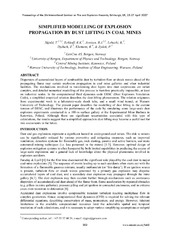Simplified modelling of explosion propagation by dust lifting in coal mines
Skjold, Trygve; Eckhoff, Rolf Kristian; Arntzen, Bjørn Johan; Lebecki, K.; Dyduch, Z.; Klemens, R.; Zydak, P.
Chapter, Peer reviewed
Published version
Permanent lenke
https://hdl.handle.net/1956/8853Utgivelsesdato
2007Metadata
Vis full innførselSamlinger
Originalversjon
In: D. Drysdale, D. Bradley, V. Molkov and R. Carvel (eds.), Proceedings of the 5th International Seminar on Fire and Explosion Hazards, Edinburgh, UK, 23-27 April 2007: 302-313Sammendrag
Dispersion of accumulated layers of combustible dust by turbulent flow or shock waves ahead of the propagating flame may sustain explosion propagation in coal mine galleries and other industrial facilities. The mechanisms involved in transforming dust layers into dust suspensions are rather complex, and detailed numerical modelling of this process is therefore practically impossible, at least on industrial scales. In the computational fluid dynamics code DESC (Dust Explosion Simulation Code), a simplified empirical relation describes the dust-lifting phenomenon. The relation originates from experimental work in a laboratory-scale shock tube, and a small wind tunnel, at Warsaw University of Technology. The present paper describes the modelling of dust lifting in the current version of DESC, and illustrates the performance of the code by simulating some large-scale dust explosion experiments conducted in a 100-m surface gallery at the Experimental Mine Barbara in Katowice, Poland. Although there are significant uncertainties associated with this type of calculations, the results suggest that a simplified approach to dust lifting may become a useful tool for risk assessments in the future.
